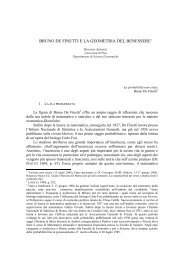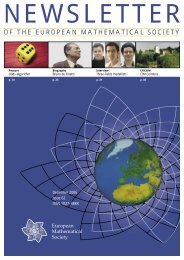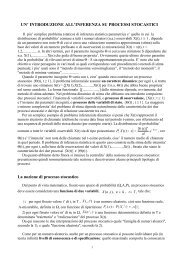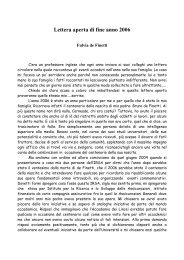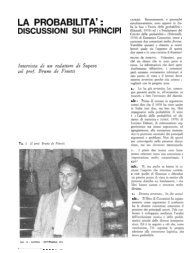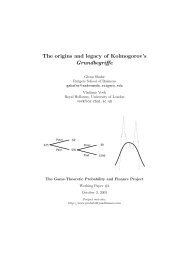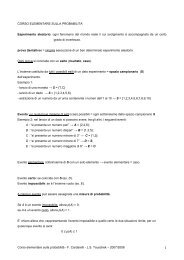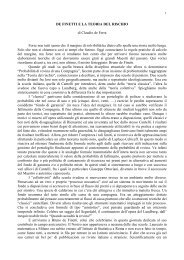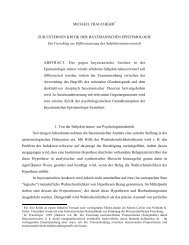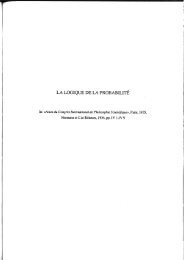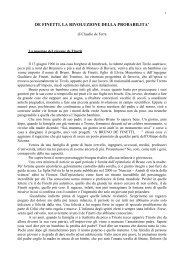The origins of quasi-concavity: a development ... - Bruno de Finetti
The origins of quasi-concavity: a development ... - Bruno de Finetti
The origins of quasi-concavity: a development ... - Bruno de Finetti
You also want an ePaper? Increase the reach of your titles
YUMPU automatically turns print PDFs into web optimized ePapers that Google loves.
Historia Mathematica 31 (2004) 62–75<br />
www.elsevier.com/locate/hm<br />
<strong>The</strong> <strong>origins</strong> <strong>of</strong> <strong>quasi</strong>-<strong>concavity</strong>: a <strong><strong>de</strong>velopment</strong> between<br />
mathematics and economics<br />
Angelo Guerraggio a,b and Elena Molho c,∗<br />
a Facoltà di Economia, Università <strong>de</strong>ll’Insubria, Via Ravasi 2, Varese, Italy<br />
b Istituto di Metodi Quantitativi, Università Bocconi, Milan, Italy<br />
c Dipartimento di Ricerche Aziendali, Università <strong>de</strong>gli Studi di Pavia, Pavia, Italy<br />
Received 28 January 2002; revised 6 February 2003; accepted 28 July 2003<br />
Abstract<br />
<strong>The</strong> <strong>origins</strong> <strong>of</strong> the notion <strong>of</strong> <strong>quasi</strong>-concave function are consi<strong>de</strong>red, with special interest in some work by John<br />
von Neumann, <strong>Bruno</strong> <strong>de</strong> <strong>Finetti</strong>, and W. Fenchel. <strong>The</strong> <strong><strong>de</strong>velopment</strong> <strong>of</strong> such pioneering studies subsequently led<br />
to a whole field <strong>of</strong> research, known as “generalized convexity.” <strong>The</strong> different styles <strong>of</strong> the three authors and the<br />
various motivations for introducing <strong>quasi</strong>-<strong>concavity</strong> are compared, without losing sight <strong>of</strong> economic applications<br />
characteristic <strong>of</strong> the whole field <strong>of</strong> generalized convexity.<br />
© 2003 Elsevier Inc. All rights reserved.<br />
Sommario<br />
Il lavoro consi<strong>de</strong>ra le origini <strong>de</strong>lla nozione di funzione <strong>quasi</strong>-concava, con particolare riguardo ad alcuni scritti di<br />
John von Neumann, di <strong>Bruno</strong> <strong>de</strong> <strong>Finetti</strong>, e di W. Fenchel. Lo sviluppo di tali studi pionieristici ha successivamente<br />
consentito lo sviluppo di un intero campo di ricerca <strong>de</strong>tto “convessità generalizzata.” I diversi stili <strong>de</strong>i tre autori<br />
e le differenti motivazioni che hanno portato all’introduzione <strong>de</strong>lla <strong>quasi</strong>-concavità vengono confrontati, senza<br />
per<strong>de</strong>re di vista il riferimento alle applicazioni economiche che costituiscono una caratteristica in tema di convessità<br />
generalizzata.<br />
© 2003 Elsevier Inc. All rights reserved.<br />
MSC: 01A60; 26B25; 52A01; 91B16; 91A10<br />
Keywords: Convexity; Quasi-convexity; Utility theory; Von Neumann; De <strong>Finetti</strong>; Fenchel<br />
* Corresponding author.<br />
E-mail addresses: angelo.guerraggio@uni-bocconi.it (A. Guerraggio), molhoe@eco.unipv.it (E. Molho).<br />
0315-0860/$ – see front matter © 2003 Elsevier Inc. All rights reserved.<br />
doi:10.1016/j.hm.2003.07.001
A. Guerraggio, E. Molho / Historia Mathematica 31 (2004) 62–75 63<br />
1. Introduction<br />
<strong>The</strong> first mo<strong>de</strong>rn formalization <strong>of</strong> the concept <strong>of</strong> convex function appears in Jensen [1905]. Since then,<br />
at first referring to “Jensen’s convex functions,” then more openly, without needing any explicit reference,<br />
the <strong>de</strong>finition <strong>of</strong> convex function becomes a standard element in calculus handbooks.<br />
A function f : C ⊆ R n → R, whereC is a convex set, is said to be convex when the following<br />
inequality holds, for any x,y ∈ C and for any t ∈[0, 1]: f(tx+ (1 − t)y) tf (x) + (1 − t)f(y).Ifthe<br />
reverse inequality holds, i.e., −f is convex, the function f is said to be concave. Such a <strong>de</strong>finition (which<br />
is based upon the three points x, y, and tx+ (1 − t)y) becomes simpler when we consi<strong>de</strong>r a smaller class<br />
<strong>of</strong> functions. A differentiable function is convex whenever, ∀x,y ∈ C, the following inequality, whose<br />
geometric meaning is apparent, holds: f(x)− f(y) ∇f (x)(y − x). Moreover, a twice differentiable<br />
function f is convex whenever, ∀x ∈ C, d 2 f(x) 0; the last inequality extends, in a natural way, the<br />
elementary rule that studies the convexity <strong>of</strong> a real function <strong>of</strong> a real variable through the sign <strong>of</strong> its<br />
second <strong>de</strong>rivative.<br />
We shall not mention the importance and the applications <strong>of</strong> a basic instrument such as convexity. We<br />
just give some hints on the topics that will be brought up later. Convexity is one <strong>of</strong> the most frequently<br />
used hypotheses in optimization theory. It is usually introduced to give global validity to propositions<br />
otherwise only locally true (for convex functions, for instance, a local minimum is also a global<br />
minimum) and to obtain sufficiency for conditions that are generally only necessary, as with the classical<br />
Fermat theorem or with Kuhn–Tucker conditions in nonlinear programming. For the history <strong>of</strong> linear<br />
and nonlinear programming one can turn to Grattan-Guinness [1989], Giorgi and Guerraggio [1998],<br />
Kjeldsen [2000]. In microeconomics, convexity plays a fundamental role in general equilibrium theory<br />
and in duality results. In particular, in consumer theory, the so-called convexity <strong>of</strong> preferences ensures<br />
the existence <strong>of</strong> a <strong>de</strong>mand function; moreover, in production theory, the convexity <strong>of</strong> the production sets<br />
(which eliminates increasing marginal returns) ensures the existence <strong>of</strong> an equilibrium production. In<br />
<strong>de</strong>cision theory, the <strong>concavity</strong> <strong>of</strong> the utility function corresponds to risk aversion for the agent. In game<br />
theory, convexity ensures the existence <strong>of</strong> an equilibrium solution: the introduction <strong>of</strong> the fundamental<br />
notion <strong>of</strong> a mixed strategy corresponds to a convexification <strong>of</strong> the strategy set. For a historical reference,<br />
see, e.g., Weintraub [1992].<br />
In the past century, the notion <strong>of</strong> a convex function has been generalized in various ways, either by<br />
an extension to abstract spaces, or by a change in the inequalities presented above. One <strong>of</strong> the more<br />
recent generalizations, for instance, is due to M.A. Hanson, who introduced invex functions in the 1980s:<br />
f : R n → R is invex whenever it is differentiable and there exists a function η : R n × R n → R n such<br />
that f(x)− f(y) ∇f(x)η(x,y). A more classical extension <strong>of</strong> convexity, only partially comparable<br />
to invex functions, is the class <strong>of</strong> <strong>quasi</strong>-convex functions. At an intermediate level <strong>of</strong> generality (at least<br />
in the continuous case) we mention pseudo-convex functions. <strong>The</strong>se classes can be characterized through<br />
the generalized monotonicity <strong>of</strong> gradient maps; see Hadjisavvas and Schaible [2001a, 2001b].<br />
Many important properties <strong>of</strong> convex functions are preserved within a wi<strong>de</strong>r functional environment.<br />
If f is convex, its lower level sets A k ={x ∈ C : f(x) k, k ∈ R} are convex; the converse implication<br />
does not hold true, as it is apparent in the case <strong>of</strong> a monotone function <strong>of</strong> a real variable. <strong>The</strong> same holds<br />
true in the concave case, referring to the convexity <strong>of</strong> the upper level sets B k ={x ∈ C : f(x) k, k ∈ R}.<br />
Quasi-convex (<strong>quasi</strong>-concave) functions are characterized by the last property: they are those functions<br />
whose level sets A k (B k ) are convex or, equivalently, those functions that satisfy the following (three<br />
points) condition: ∀x,y ∈ C, ∀t ∈[0, 1], f(tx + (1 − t)y) max{f(x),f(y)}, (f (tx + (1 − t)y)
64 A. Guerraggio, E. Molho / Historia Mathematica 31 (2004) 62–75<br />
min{f(x),f(y)}). It is easily seen that, in the case <strong>of</strong> real functions <strong>of</strong> one real variable, every monotone<br />
function is <strong>quasi</strong>-convex (and <strong>quasi</strong>-concave). <strong>The</strong> <strong>de</strong>scription <strong>of</strong> the class <strong>of</strong> <strong>quasi</strong>-convex functions<br />
and <strong>of</strong> their properties is <strong>de</strong>veloped following the same pattern as in the convex case; for differentiable<br />
functions, instead <strong>of</strong> consi<strong>de</strong>ring the inequality f(y)− f(x) ∇f (x)(y − x), it is enough to require<br />
that ∇f (x)(y − x) 0implyf(y)− f(x) 0.<br />
We do not mention other variations on the topic <strong>of</strong> generalized convexity here. Thus we refer to<br />
Schaible and Ziemba [1981] and Avriel et al. [1988]. All the <strong>de</strong>finitions follow a pattern that reproduces<br />
the relationships among convex, strictly convex, and strongly convex functions where some special<br />
properties are preserved.<br />
In this paper we wish to analyze the first contributions to <strong>quasi</strong>-<strong>concavity</strong>, either to pinpoint the reasons<br />
such a notion was introduced or to <strong>de</strong>scribe how the same i<strong>de</strong>a <strong>of</strong> a <strong>quasi</strong>-concave function has been<br />
<strong>de</strong>veloped following different routes. Its history <strong>de</strong>velops along the second half <strong>of</strong> the last century, but<br />
we find some puzzle, even on priority.<br />
2. <strong>Bruno</strong> <strong>de</strong> <strong>Finetti</strong><br />
<strong>Bruno</strong> <strong>de</strong> <strong>Finetti</strong> (1906–1985) is one <strong>of</strong> the mathematicians whose name is usually linked to the<br />
introduction <strong>of</strong> the class <strong>of</strong> <strong>quasi</strong>-concave functions. In 1949—the year <strong>of</strong> publication <strong>of</strong> his work “Sulle<br />
stratificazioni convesse” [<strong>de</strong> <strong>Finetti</strong>, 1949]—<strong>de</strong> <strong>Finetti</strong> was a full pr<strong>of</strong>essor <strong>of</strong> financial mathematics<br />
at Trieste. He obtained his <strong>de</strong>gree in “applied mathematics” in 1927 in Milan, where he atten<strong>de</strong>d the<br />
courses in economics held by Ulisse Gobbi at the Politecnico. <strong>The</strong>n he worked first in Rome at the<br />
mathematical <strong>de</strong>partment <strong>of</strong> the “Istituto Centrale di Statistica” and subsequently in Trieste, as actuary<br />
in a major insurance company. In the years between the two wars <strong>de</strong> <strong>Finetti</strong> conceived the main i<strong>de</strong>as<br />
that would make him a protagonist in mo<strong>de</strong>rn probability theory: first the subjective approach, then the<br />
study <strong>of</strong> exchangeable processes and a formulation <strong>of</strong> the general theory <strong>of</strong> processes with in<strong>de</strong>pen<strong>de</strong>nt<br />
increments. We limit ourselves to giving just some chronological references in or<strong>de</strong>r to emphasize<br />
the preeminent role played by this young researcher in the field <strong>of</strong> probability theory. For a <strong>de</strong>tailed<br />
bibliography on the work <strong>of</strong> <strong>de</strong> <strong>Finetti</strong>, see also Daboni [1987]. Between 1928 and 1930 the journal<br />
Rendiconti <strong>de</strong>ll’Istituto Lombardo published some articles stimulating controversy between <strong>de</strong> <strong>Finetti</strong><br />
and Fréchet about the hypothesis <strong>of</strong> σ -additivity. In 1937, the Annales <strong>de</strong> l’Institut M. Poincaré published<br />
the text <strong>of</strong> a cycle <strong>of</strong> five lessons held at the Institute two years before, where <strong>de</strong> <strong>Finetti</strong> stated in an<br />
almost final version his subjectivist point <strong>of</strong> view on probability. Moreover, in 1937, <strong>de</strong> <strong>Finetti</strong> is among<br />
the protagonists <strong>of</strong> the Colloque consacré à la theorie <strong>de</strong>s probabilités, organized by the University <strong>of</strong><br />
Genève in the frame <strong>of</strong> a series <strong>of</strong> meetings held yearly in or<strong>de</strong>r to examine a given subject thoroughly.<br />
In the same years <strong>de</strong> <strong>Finetti</strong> was an outstanding figure in the Italian mathematical world. He was one<br />
<strong>of</strong> the first scholars to study the applications <strong>of</strong> mathematics to economic and social sciences. Together<br />
with masters such as Guido Castelnuovo and Francesco Paolo Cantelli, he may be consi<strong>de</strong>red one <strong>of</strong> the<br />
foun<strong>de</strong>rs <strong>of</strong> the Italian school <strong>of</strong> probabilistic studies. He <strong>de</strong>voted special attention to the methodological<br />
aspects in his studies: he <strong>de</strong>clared the importance <strong>of</strong> abstract and general research, in or<strong>de</strong>r to obtain a<br />
<strong>de</strong>eper un<strong>de</strong>rstanding <strong>of</strong> social behavior. Contemporary Italian mathematicians, influenced by a tradition<br />
going back to the 17th century, hesitated to follow the mo<strong>de</strong>rn algebraic formal methods. Besi<strong>de</strong>s, the<br />
cultural atmosphere urged the <strong><strong>de</strong>velopment</strong> <strong>of</strong> a pragmatic science, <strong>de</strong>voted to solve the real problems <strong>of</strong><br />
the country, and <strong>de</strong> <strong>Finetti</strong> himself had never forsaken a social conscience.
A. Guerraggio, E. Molho / Historia Mathematica 31 (2004) 62–75 65<br />
In the 1930s, when the fascist dictatorship took hold in Italy, <strong>de</strong> <strong>Finetti</strong> saw in the new government<br />
the revolutionary possibility <strong>of</strong> creating a “third way,” superior both to liberalism and to socialism. <strong>The</strong><br />
refusal <strong>of</strong> every compromise with the new liberal world allowed him to conceive ex novo a globally<br />
fascist i<strong>de</strong>a <strong>of</strong> life (and <strong>of</strong> economy): “in the free-tra<strong>de</strong> economy the individual is subject to the system<br />
that presupposes egoism and compels to egoism even those who un<strong>de</strong>rstand that the result <strong>of</strong> all egoism<br />
is chaos and ruin; only the discipline <strong>of</strong> an outer command may rescue one from the slavery <strong>of</strong> freedom,<br />
from the slavery <strong>of</strong> anarchy” [<strong>de</strong> <strong>Finetti</strong>, 1943, p. 48]. <strong>The</strong> 1929 <strong>de</strong>pression was experienced as an<br />
unambiguous sign <strong>of</strong> the crisis <strong>of</strong> the system and <strong>of</strong> the <strong>de</strong>feat <strong>of</strong> economic theory, not fit to account<br />
for the new phenomena: “it is already too evi<strong>de</strong>nt that the doctrine and the system urgently need a <strong>de</strong>ep<br />
revision for anybody to <strong>de</strong>ny it in good faith, unless he lives in the clouds or on a university chair”<br />
[<strong>de</strong> <strong>Finetti</strong>, 1935a, p. 364]. <strong>The</strong> criticism <strong>of</strong> the Paretian system, <strong>de</strong>veloped on the basis <strong>of</strong> strong ethical<br />
expectations in a group <strong>of</strong> articles that introduce the themes <strong>of</strong> welfare economics, led him to a position<br />
that was absolutely original in the framework <strong>of</strong> Italian mathematics in the 1930s: one should “not give<br />
up, but increasingly refine the subtle mathematical sharpness that clearly distinguishes Pareto from other<br />
economists, one should let go <strong>of</strong> the contacts with historical reality instead <strong>of</strong> holding them fast, one<br />
should make a cleaner and stricter distinction between science and the assessment <strong>of</strong> the aim for which<br />
one can exploit it” [<strong>de</strong> <strong>Finetti</strong>, 1935b, p. 230]. In short, to reach the truth, one should not “give up the<br />
too abstract character <strong>of</strong> Pareto’s i<strong>de</strong>as to watch reality closer, but, on the contrary, one should make<br />
abstractness more perfectly coherent” [<strong>de</strong> <strong>Finetti</strong>, 1935b, p. 230].<br />
In 1954, <strong>de</strong> <strong>Finetti</strong> (who was in Trieste when “Sulle stratificazioni convesse” was published) moved<br />
to the University <strong>of</strong> Rome. <strong>The</strong> institutions had changed. De <strong>Finetti</strong> changed his political options, but<br />
kept his attention fixed upon political themes. He assumed a critical tone: “the necessity to <strong>de</strong>sign and to<br />
accomplish a different economic system is urgent not only in answer to the needs <strong>of</strong> the community: it<br />
must be achieved so as to save humanity from self-<strong>de</strong>struction as well” [<strong>de</strong> <strong>Finetti</strong>, 1973, p. 77].<br />
Hereafter we study the work “Sulle stratificazioni convesse,” a technical article issued in 1949 in<br />
“Annali di Matematica Pura e Applicata,” where the notion <strong>of</strong> <strong>quasi</strong>-<strong>concavity</strong> is introduced. It is the<br />
first time that <strong>de</strong> <strong>Finetti</strong> <strong>de</strong>voted his attention to this topic, even if the main issues <strong>of</strong> his paper can find<br />
a natural setting in the i<strong>de</strong>as <strong>of</strong> contemporary mathematicians, always paying attention to social and<br />
economic applications.<br />
<strong>The</strong> work begins with three problems that we formulate in mo<strong>de</strong>rn terms:<br />
(a) Is a <strong>quasi</strong>-concave function concave as well? Or, in the words <strong>of</strong> <strong>de</strong> <strong>Finetti</strong>, “given a family <strong>of</strong> convex<br />
regions, one insi<strong>de</strong> the other or, as we say for the sake <strong>of</strong> brevity, a convex stratification, is it possible<br />
to associate a convex function f(P) with it, as stated before? or, briefly, is it a stratification <strong>of</strong> a<br />
convex function?”<br />
(b) Assuming a negative answer to the first question, does there always exist, for a given <strong>quasi</strong>-concave<br />
function ϕ, an increasing transformation F such that the composition f = F [ϕ] is concave?<br />
(c) Assuming a positive answer to the second question (consi<strong>de</strong>ring as equivalent all the functions<br />
z = h + kf , with h, k ∈ R), does a function F [ϕ] that is the least concave exist, i.e., one satisfying<br />
the inequality F [ϕ] G[ϕ] for any increasing transformation G such that G[ϕ] is concave?<br />
In his work, <strong>de</strong> <strong>Finetti</strong> uses the term “convex function” to <strong>de</strong>note what is usually called a concave<br />
function. In the sequel we will use the mo<strong>de</strong>rn terminology. Now, we will study the <strong>de</strong>tails <strong>of</strong> <strong>de</strong> <strong>Finetti</strong>’s<br />
work and the answers he gives to his own problems, focusing on some inexactnesses and on what
66 A. Guerraggio, E. Molho / Historia Mathematica 31 (2004) 62–75<br />
may be consi<strong>de</strong>red an extreme reliance on geometric intuition (due to his special mathematical style).<br />
Nevertheless, the originality <strong>of</strong> his intuitions and the consciousness <strong>of</strong> the <strong>de</strong>ep connections between<br />
the analytical problems, subjects <strong>of</strong> the preceding questions, and the economic mo<strong>de</strong>ls should not be<br />
un<strong>de</strong>rvalued.<br />
<strong>The</strong> first paragraph—“Generalities”—containing the enunciation <strong>of</strong> the three problems mentioned<br />
above, also shows the style and the methods <strong>of</strong> the whole article (it is <strong>de</strong> <strong>Finetti</strong>’s typical mathematical<br />
style). In <strong>de</strong> <strong>Finetti</strong>’s own words there is reference—immediate and explicit—to the problems <strong>of</strong><br />
economic analysis. <strong>The</strong> analysis <strong>of</strong> what will be called <strong>quasi</strong>-<strong>concavity</strong> was suggested to <strong>de</strong> <strong>Finetti</strong> from<br />
utility theory, as the author acknowledges. <strong>The</strong> discussion <strong>of</strong> the first problem is justified by the statement<br />
that, in mathematical economics, “it seems to be <strong>de</strong>emed” that from the convexity <strong>of</strong> the regions <strong>de</strong>limited<br />
from the indifference varieties the <strong>concavity</strong> <strong>of</strong> the utility in<strong>de</strong>x necessarily follows. <strong>The</strong> second problem<br />
makes an implicit reference to the dispute between ordinalists and cardinalists. <strong>The</strong> basic assumption <strong>of</strong><br />
the utilitarian revolution was the rational behavior <strong>of</strong> the consumer, who was consi<strong>de</strong>red to be able to<br />
rank his needs; it seemed that the existence <strong>of</strong> a function (<strong>of</strong> consumable goods) that measured utility<br />
was unavoidable. This fundamental concept—utility—was then <strong>de</strong>fined as a measurable quantity in the<br />
cardinal sense, unique but for linear increasing transformations. But, at the end <strong>of</strong> the 19th century,<br />
Pareto’s work appears with a new awareness that will lead to the ordinalist paradigm proposed by Hicks<br />
and Allen (1934). <strong>The</strong>y say that it is not at all necessary to assume the cardinal measurability <strong>of</strong> utility;<br />
utility is just the expression <strong>of</strong> the preferences <strong>of</strong> the consumer, represented by the indifference curves<br />
<strong>of</strong> the agent (the level sets <strong>of</strong> the function), unique but for monotone increasing transformations. In the<br />
second problem, the author won<strong>de</strong>rs if in the class <strong>of</strong> functions that represent the utility <strong>of</strong> the consumer,<br />
there is a concave function.<br />
So the i<strong>de</strong>a <strong>of</strong> a <strong>quasi</strong>-concave function f , which represent a “convex stratification,” for which “the<br />
regions <strong>de</strong>fined by the inequality f(p) c obviously make up (as the constant c changes) a family <strong>of</strong><br />
convex regions” is not based merely on formal reasons, with a subsequent application and exemplification<br />
in economic analysis—almost to prove the significance <strong>of</strong> the mathematical procedure. On the contrary,<br />
in <strong>de</strong> <strong>Finetti</strong> the introduction <strong>of</strong> <strong>quasi</strong><strong>concavity</strong> is justified by economic theory. We can say, with some<br />
emphasis, according to the spirit <strong>of</strong> <strong>de</strong> <strong>Finetti</strong>’s work, that generalized convexity has been intimately<br />
connected with utility theory since it began.<br />
Afterwards the topic is <strong>de</strong>veloped in strictly mathematical terms. <strong>The</strong> formal level is characterized<br />
by the strong presence <strong>of</strong> intuition and <strong>of</strong> geometric methods and language. Geometric terms such as<br />
“bottlenecks,” “infinitely thin layers,” “contours,” and “in<strong>de</strong>ntations” are present. For the sake <strong>of</strong> clarity,<br />
the author makes reference to pictures <strong>of</strong> special cases, in a period when the mathematical style is<br />
already sufficiently aligned to mo<strong>de</strong>rn abstract standards. Other propositions are explicitly proved in<br />
a geometric way. On the whole, the paper is not segmented into lemmas, theorems, pro<strong>of</strong>s, remarks,<br />
examples, but is the <strong><strong>de</strong>velopment</strong> <strong>of</strong> a unique subject thought <strong>of</strong> and “seen” in geometric terms and then<br />
written in an analytic language that maintains some hints <strong>of</strong> the un<strong>de</strong>rlying structure, where, e.g., some<br />
continuity assumption is left out or some pro<strong>of</strong> that is <strong>de</strong>emed evi<strong>de</strong>nt and immediate in a geometric<br />
three-dimensional intuition is omitted.<br />
In this way <strong>de</strong> <strong>Finetti</strong> is able to give an answer to the second question. Generally his answer is<br />
negative, but it becomes positive whenever the function ϕ “is assumed to have boun<strong>de</strong>d first and second<br />
<strong>de</strong>rivatives.” <strong>The</strong> example, consi<strong>de</strong>red in a footnote, <strong>of</strong> a function ϕ (<strong>of</strong> one real variable) and <strong>of</strong> its<br />
transformation f(x)= e −λϕ(x) , for which one has f ′′ (x) =−λe −λϕ(x) [λ(ϕ ′ (x)) 2 − ϕ ′′ (x)], showsthat<br />
<strong>concavity</strong> <strong>of</strong> f is ensured if one takes λ “large enough” (λ >ϕ ′′ (x)/[ϕ ′ (x)] 2 ), but this is true if ϕ ′′ is
A. Guerraggio, E. Molho / Historia Mathematica 31 (2004) 62–75 67<br />
boun<strong>de</strong>d and ϕ ′ is far from zero. Another doubtful point is the sentence concerning the domain <strong>of</strong> the<br />
functions consi<strong>de</strong>red. De <strong>Finetti</strong> says that every remark will refer to finite-dimensional spaces, even if<br />
its extension to the infinite-dimensional case is not a problem. What you have to do is “to give up—it<br />
is not a clear remark—those conclusions arising from the possibility <strong>of</strong> consi<strong>de</strong>ring maxima instead <strong>of</strong><br />
suprema.”<br />
If we go back to the three main problems <strong>of</strong> the paper, we find that a generally negative answer to<br />
the first two problems is given immediately, through some geometrical examples: there are some convex<br />
stratifications that are not stratifications <strong>of</strong> concave functions; moreover, the concavification <strong>of</strong> a <strong>quasi</strong>concave<br />
function “would not be true if some restriction were not imposed.” Now, taking for granted that<br />
such restrictions are implicitly imposed to be certain that the class <strong>of</strong> concavifying transformations is<br />
nonempty, <strong>de</strong> <strong>Finetti</strong> <strong>de</strong>votes himself to the third question. Here there is no direct reference to economic<br />
problems, but during the same years <strong>de</strong> <strong>Finetti</strong> worked on the utility theory, where he emphasized<br />
the relevance <strong>of</strong> the notion <strong>of</strong> relative <strong>concavity</strong> (see, e.g., <strong>de</strong> <strong>Finetti</strong> [1952]). <strong>The</strong>se i<strong>de</strong>as would be<br />
<strong>de</strong>veloped later, when the notion <strong>of</strong> risk aversion was introduced by Pratt and Arrow [Pratt, 1964;<br />
Arrow, 1970], and their relation to <strong>concavity</strong> would be <strong>de</strong>veloped. An economic agent is risk-averse if and<br />
only if his utility function is concave and its “<strong>concavity</strong> <strong>de</strong>gree” represents a measure <strong>of</strong> risk-aversion.<br />
<strong>The</strong> first step in the construction <strong>of</strong> the least concave function is a lemma concerning the construction<br />
<strong>of</strong> the least concave function greater than a given function ψ <strong>de</strong>fined on a set C: “let f(P) =<br />
sup . ∑ ∑ h λ hψ(P h ) where the supremum is calculated consi<strong>de</strong>ring all the possible expressions <strong>of</strong> P =<br />
k λ kP k as a linear combination with coefficients λ k > 0 <strong>of</strong> any (finite) number <strong>of</strong> points P k <strong>of</strong> C; it<br />
results that f(P)is convex and that, on the whole C, f(P) ψ(P), while f(P) ϕ(P) whenever ϕ is<br />
any other convex function ϕ(P).” In <strong>de</strong> <strong>Finetti</strong>’s opinion “the pro<strong>of</strong> is obvious,” so it is omitted. From<br />
a mo<strong>de</strong>rn point it is not so trivial. As a matter <strong>of</strong> fact, in a recent monograph on convex analysis [Hiriart-<br />
Urruty and Lemaréchal, 1993] we can find the following theorem (Proposition 2.5.1, I, p. 169): “Let<br />
g : R n → R ∪{+∞}, not i<strong>de</strong>ntically +∞, be minorized by an affine function: for some (s, b) ∈ R n × R,<br />
g(x) (s, x) − b, forallx ∈ R n . <strong>The</strong>n, the following three functions f 1 , f 2 , f 3 are convex and coinci<strong>de</strong><br />
on R n :<br />
f 1 (x) = inf { r: (x, r) ∈ co epi g }<br />
f 2 (x) = sup { h(x): h ∈ Conv R n ,h g }<br />
{ k∑<br />
}<br />
k∑<br />
f 3 (x) = inf α j g(x j ): k = 1, 2,...,α∈ k ,x j ∈ dom g, α j x j = x .”<br />
j=1<br />
j=1<br />
<strong>The</strong> meaning <strong>of</strong> the symbols is apparent: co epi g, Conv R n , dom g are, respectively, the smallest<br />
convex set containing the epigraph <strong>of</strong> a function g, the set <strong>of</strong> convex functions <strong>de</strong>fined on R n ,and<br />
the effective domain <strong>of</strong> the function g. If such mo<strong>de</strong>rn language is translated into <strong>de</strong> <strong>Finetti</strong>’s terms,<br />
it can be immediately seen that the preceding theorem is nothing but <strong>de</strong> <strong>Finetti</strong>’s lemma (which does not<br />
consi<strong>de</strong>r the function f 1 ), with one, or better yet, two differences: the pro<strong>of</strong> given by Hiriart-Urruty and<br />
Lemaréchal is longer than one page and, moreover, there is an assumption that is ignored by <strong>de</strong> <strong>Finetti</strong><br />
(and not replaced by anything else). And it is an essential hypothesis, as can easily be seen by consi<strong>de</strong>ring<br />
the function g(x) = x 3 ; there exists no affine minorizing function for g, and the three functions f 1 , f 2 ,<br />
and f 3 are i<strong>de</strong>ntically −∞.<br />
<strong>The</strong> monograph by Hiriart-Urruty and Lemaréchal was published only recently, but <strong>de</strong> <strong>Finetti</strong> had<br />
the possibility <strong>of</strong> realizing that he nee<strong>de</strong>d a hypothesis or, in someway, doubting <strong>of</strong> the generality <strong>of</strong>
68 A. Guerraggio, E. Molho / Historia Mathematica 31 (2004) 62–75<br />
his result. In [Ascoli, 1935] a preceding work was quoted on the minimal non<strong>de</strong>creasing function greater<br />
than a given real function <strong>de</strong>fined on an interval [a,b]. Ascoli was a known mathematician in Italy, even if<br />
not first rank; moreover, he published his note in a prestigious journal, whose fame was well-established.<br />
<strong>The</strong> work is based on a theorem—well emphasized—where the least concave (continuous) function is<br />
constructed greater than any boun<strong>de</strong>d function on an interval [a,b]. <strong>The</strong> boun<strong>de</strong>dness assumption just<br />
allows Ascoli to assert the existence <strong>of</strong> majorizing linear functions.<br />
De <strong>Finetti</strong>’s lemma is followed by “two different procedures to construct a least convex function.”<br />
<strong>The</strong> former is an iterative procedure, which uses the preceding lemma and may be resumed as follows.<br />
Given the (convex) indifference varieties <strong>of</strong> a function ϕ <strong>de</strong>fined on an affine space S, with min ϕ = a,<br />
max ϕ = b, take the function ϕ 0 (P ) as follows,<br />
{<br />
a, ϕ(P) ≠ b,<br />
ϕ 0 (P ) =<br />
b , ϕ(P)= b,<br />
where P ∈ S.<br />
<strong>The</strong> function ϕ 1 is given by the preceding lemma, so it is the least concave function greater than ϕ 0 ;<br />
we can build ϕ 2 by consi<strong>de</strong>ring the least function greater than ϕ 1 and constant where ϕ was constant. We<br />
can now iterate this procedure and we build two sequences <strong>of</strong> functions: {ϕ 2k+1 } is a sequence <strong>of</strong> concave<br />
functions, while {ϕ 2k } is constant wherever ϕ is constant. <strong>The</strong> existence <strong>of</strong> the limit <strong>of</strong> {ϕ k },fork →+∞,<br />
is ensured by monotonicity. <strong>The</strong> limit function f is what we were looking for, since it is concave (it is<br />
the limit <strong>of</strong> the concave functions ϕ 2k+1 ) and it is “constant on the prescribed level varieties” (it is the<br />
limit <strong>of</strong> the functions ϕ 2k ). De <strong>Finetti</strong> just fears the circumstances that can ren<strong>de</strong>r the geometric procedure<br />
<strong>de</strong>scribed above, or the situations that “prevent the existence <strong>of</strong> the convex function one was looking for<br />
(or better: that make it <strong>de</strong>generate into a constant).” But the only <strong>de</strong>generate solution is ϕ(x) ≡ b; asa<br />
matter <strong>of</strong> fact, if it were the case that ϕ(x) = c, even only on a set containing an interior point Q, from<br />
ϕ(P) = b>cand ϕ(R) = c (where R is a point <strong>of</strong> the segment PQ beyond Q) it would follow that<br />
ϕ(Q) = tϕ(P)+ (1 − t)ϕ(R)> tc + (1 − t)c = c.<br />
<strong>The</strong> latter is a more analytical procedure for the construction <strong>of</strong> a least concave function. First <strong>de</strong> <strong>Finetti</strong><br />
proves a necessary and sufficient condition, which implicitly confirms the negative answer given to the<br />
first problem: a <strong>quasi</strong>-concave function ϕ is concave if and only if all its pr<strong>of</strong>iles ϕ ξ are concave, where<br />
the function ϕ ξ is <strong>de</strong>fined through the linear transformations ξ: ϕ ξ (x) = sup P ϕ(P), ξ(P) = x. In a hint<br />
contained in a footnote, the pro<strong>of</strong> brings forward the notion <strong>of</strong> the subgradient <strong>of</strong> a convex function,<br />
introduced by R.T. Rockafellar in the 1970s. We can find some inexactness (for instance, the maxima<br />
<strong>of</strong> ϕ are treated without having ensured their existence and, in particular, the boun<strong>de</strong>dness <strong>of</strong> a given<br />
closed set). Later the <strong>concavity</strong> condition on the pr<strong>of</strong>iles is rewritten equivalently, through a functional<br />
inequality, by the use <strong>of</strong> Ra<strong>de</strong>macher’s theorem (1919) that <strong>de</strong> <strong>Finetti</strong> exploits in a special form and<br />
without any explicit quotation: a concave function is “<strong>de</strong>rivable except for at most a numerable infinity<br />
<strong>of</strong> cusps.” <strong>The</strong> least concave function is the function that satisfies this inequality in the limit case <strong>of</strong><br />
equality, i.e., solves the differential equation ϕ ′ ξ (x) = kW x(x 1 ,x), with k = ϕ ′ ξ (x 1) and W x built through<br />
elements <strong>of</strong> ϕ, and is therefore characterized by the following pr<strong>of</strong>iles:<br />
ϕ ξ (x) = h + k<br />
∫ x 2<br />
x 1<br />
W(x 1 ,u)du.
A. Guerraggio, E. Molho / Historia Mathematica 31 (2004) 62–75 69<br />
<strong>The</strong> second procedure (the more analytical one) for constructing the least concave function is exposed<br />
in the fifth paragraph, where <strong>de</strong> <strong>Finetti</strong> remarks, without pro<strong>of</strong>, that “it is useful to remark, as a corollary,<br />
the following characteristic <strong>of</strong> least convex functions: if and only if ϕ is the least convex function,<br />
f = F [ϕ] is convex only if F is increasing and convex.”<br />
This property leads us to treat a recent contribution [Debreu, 1976]. Debreu studies the third problem<br />
<strong>of</strong> <strong>de</strong> <strong>Finetti</strong>, whom he quotes explicitly, with a formally different <strong>de</strong>finition <strong>of</strong> the least concave function.<br />
He <strong>de</strong>fines a preor<strong>de</strong>r on the set U <strong>of</strong> continuous, concave, real-valued functions on X representing the<br />
same stratification: v is more concave than u if there is a real-valued, concave function f on u(X)<br />
such that v = f(u). Actually the two notions are equivalent, as Debreu himself proves by constructing<br />
the minimal element according to his own <strong>de</strong>finition. This coinci<strong>de</strong>nce was already stated by <strong>de</strong> <strong>Finetti</strong><br />
without any pro<strong>of</strong>. In Debreu’s work it is emphasized in a long and complex pro<strong>of</strong>. Another author, who<br />
studied the second problem <strong>of</strong> <strong>de</strong> <strong>Finetti</strong>, i.e., the concavificability <strong>of</strong> a convex stratification, is Y. Kannai.<br />
<strong>The</strong> concavificability conditions which are the main result <strong>of</strong> his works—see, e.g., Kannai [1977]—<br />
follow some results by W. Fenchel, who first carried on some original i<strong>de</strong>as by <strong>de</strong> <strong>Finetti</strong>; moreover, the<br />
concave function, which results from the concavification procedure proposed by Kannai in his pro<strong>of</strong>s,<br />
is the least concave function representing the convex stratification. Once again, we have to focus on the<br />
heavy assumptions that Kannai makes in or<strong>de</strong>r to prove his results.<br />
3. Werner Fenchel<br />
<strong>The</strong> works where the notion <strong>of</strong> <strong>quasi</strong>-<strong>concavity</strong> (or <strong>quasi</strong>-convexity) is quoted and where some hint<br />
to its <strong>origins</strong> is ma<strong>de</strong> usually make reference to the name <strong>of</strong> Werner Fenchel. Actually his monograph—<br />
Convex Cones, Sets and Functions [Fenchel, 1953]—is the second published work where <strong>quasi</strong>-convex<br />
functions are studied but it is the first one where this word is explicitly used.<br />
Werner Fenchel (1905–1988), born in Berlin, after obtaining a <strong>de</strong>gree in mathematics, took the first<br />
steps <strong>of</strong> his aca<strong>de</strong>mic carrier in Göttingen, as an assistant <strong>of</strong> E. Landau. After some months spent, thanks<br />
to a scholarship, in Rome with T. Levi-Civita and in Copenhagen with H. Bohr and T. Bonnesen, he<br />
went to Denmark—with a pause in Swe<strong>de</strong>n—to escape the rise <strong>of</strong> Nazism. In Denmark he taught—at the<br />
Technical School and at the University <strong>of</strong> Copenhagen until 1974. <strong>The</strong> monograph we will consi<strong>de</strong>r was<br />
written in the brief American period (from 1949 to 1951), when he visited the University <strong>of</strong> Southern<br />
California, and then Stanford and Princeton. In the last university, Fenchel was invited by A.W. Tucker<br />
to hold a series <strong>of</strong> seminars on convexity, which <strong>of</strong>fered him hints and materials for the book he would<br />
publish in 1953. It is not by chance that Convex Cones, Sets and Functions begins with acknowledgments<br />
to “Pr<strong>of</strong>essor A.W. Tucker” (and to H.W. Kuhn, for his “critical remarks”) for drawing his attention to<br />
the work <strong>of</strong> <strong>de</strong> <strong>Finetti</strong> and to the concavifiability problem. Fenchel published about 50 works on real<br />
and complex analysis, on convex analysis, on geometry, and on differential geometry; the monograph<br />
on the <strong>The</strong>orie <strong>de</strong>r Körper [Bonnesen and Fenchel, 1934]—translated into English, published in various<br />
editions, and quoted by <strong>de</strong> <strong>Finetti</strong>—may be regar<strong>de</strong>d, together with Convex Cones, Sets and Functions,<br />
as his most significant publication.<br />
Convex Cones, Sets and Functions is divi<strong>de</strong>d into three chapters, whose topics appear in the title. Every<br />
subject is <strong>de</strong>veloped in finite-dimensional spaces and a special attention is <strong>de</strong>voted to “results having<br />
applications in the theory <strong>of</strong> games and in programming problems.” But, in spite <strong>of</strong> this setting, which<br />
might lead to a mainly “applied” approach, the structure and the style <strong>of</strong> Fenchel’s work are completely
70 A. Guerraggio, E. Molho / Historia Mathematica 31 (2004) 62–75<br />
different from what we found in <strong>de</strong> <strong>Finetti</strong>’s. Here, the distinction between the original problem and<br />
the theory, which is <strong>de</strong>veloped with the aim to solve it, is just a fact. <strong>The</strong> possible applications are just<br />
mentioned, in fact, in the Introduction; afterwards the theme is <strong>de</strong>veloped in total autonomy, just based<br />
on the principle <strong>of</strong> its own organic unity, and it is much easier to follow than in <strong>de</strong> <strong>Finetti</strong>, with a result<br />
closer to the mo<strong>de</strong>rn standard.<br />
We are directly interested in the seventh and the eighth paragraph <strong>of</strong> the third chapter. <strong>The</strong>y start from<br />
the same issue as the second problem <strong>of</strong> <strong>de</strong> <strong>Finetti</strong> in terms <strong>of</strong> convex functions. Fenchel, who is not<br />
interested in the existence and construction <strong>of</strong> most convex functions, consi<strong>de</strong>rs the lower level sets <strong>of</strong> a<br />
lower semicontinuous real-valued function ϕ (<strong>de</strong>fined on a convex set D ⊆R n ) and immediately obtains<br />
some <strong>of</strong> their properties. Now he won<strong>de</strong>rs whether, “conversely,” such a family <strong>of</strong> sets L τ (in<strong>de</strong>xed by a<br />
real number and satisfying the same properties) may be consi<strong>de</strong>red in some sense generated by a convex<br />
function: “un<strong>de</strong>r what conditions is a family <strong>of</strong> sets L τ satisfying I–IV transformable into the family <strong>of</strong><br />
level sets <strong>of</strong> a convex function.” <strong>The</strong> conditions I–IV are<br />
⋃<br />
I L τ = D,<br />
τ<br />
II τ 1 τ 0<br />
IV L τ is a closed set,<br />
while the previously quoted transformation is ma<strong>de</strong> through a continuous and strictly increasing function.<br />
This is nothing but the second problem issued by <strong>de</strong> <strong>Finetti</strong>, with some continuity requirements that were<br />
not explicitly ma<strong>de</strong> in his work but that in fact were geometrically consi<strong>de</strong>red. Conditions I–IV are not<br />
sufficient, nor do they become sufficient even if we add the obvious requirement that the sets L τ are<br />
convex. Here Fenchel introduces the term “<strong>quasi</strong>-convexity,” enunciating and proving for the first time<br />
the equivalence <strong>of</strong> the two <strong>de</strong>finitions that we recalled in our Introduction.<br />
Paragraph 7 is <strong>de</strong>veloped through a group <strong>of</strong> necessary and sufficient conditions to ensure that a family<br />
<strong>of</strong> convex sets (satisfying the above-mentioned properties) is the family <strong>of</strong> the lower level sets <strong>of</strong> a convex<br />
function. <strong>The</strong> first <strong>of</strong> these characterizations states that a <strong>quasi</strong>-convex function is convex if and only if<br />
the inclusion<br />
λL τ0 + (1 − λ)L τ1 ⊂ L τλ ,<br />
holds, where λ ∈[0, 1] and τ λ = λτ 0 + (1 − λ)τ 1 . In force <strong>of</strong> this necessary and sufficient condition (and<br />
<strong>of</strong> other propositions, which make use <strong>of</strong> “mo<strong>de</strong>rn” instruments <strong>of</strong> convex analysis, such as the support<br />
function and the asymptotic cone), Fenchel proves the same necessary and sufficient condition we found<br />
in <strong>de</strong> <strong>Finetti</strong> on the convexity <strong>of</strong> the pr<strong>of</strong>iles. In <strong>de</strong> <strong>Finetti</strong>’s pro<strong>of</strong> we pointed out a lack <strong>of</strong> exactness<br />
in the implicit use <strong>of</strong> a boun<strong>de</strong>dness assumption on some sets. It is the same remark that, in the final<br />
notes and in general terms, leads Fenchel to claim the originality <strong>of</strong> his own procedure and to un<strong>de</strong>rline<br />
the greater generality <strong>of</strong> his results (without any direct criticism on the Italian mathematician): “[...] is a<br />
generalization to the case consi<strong>de</strong>red here <strong>of</strong> a result <strong>of</strong> <strong>de</strong> <strong>Finetti</strong>” who always used “the assumption that<br />
the domain D and, thus, all level sets are compact and convex.”<br />
Paragraph 8 is <strong>de</strong>voted to the same problem, but un<strong>de</strong>r differentiability assumptions. Fenchel begins to<br />
prove three necessary conditions that a <strong>quasi</strong>-convex function must satisfy in or<strong>de</strong>r to obtain the existence
A. Guerraggio, E. Molho / Historia Mathematica 31 (2004) 62–75 71<br />
<strong>of</strong> a function F strictly increasing such that f = F [ϕ] is a convex function: ϕ cannot have critical points,<br />
except for those where it reaches its global minimum; for any x ∈ D, the quadratic form<br />
∑<br />
ϕ ij ′′ (x)y iy j ,<br />
i,j<br />
restricted to the hyperplane<br />
∑<br />
ϕ i ′ (x)y i = 0<br />
i<br />
must be positive semi<strong>de</strong>finite and the rank <strong>of</strong> the same unconstrained quadratic form is at most r<br />
(where r − 1 <strong>de</strong>notes the rank <strong>of</strong> the constrained quadratic form); the rate F ′′ (τ)/F ′ (τ) must satisfy<br />
a boun<strong>de</strong>dness condition from below. <strong>The</strong> same conditions, as a whole, are also sufficient. Here the<br />
comparison with <strong>de</strong> <strong>Finetti</strong> can be referred only to a note, where the Italian mathematician ma<strong>de</strong> a hint<br />
toward the differentiable case. We have already remarked that his argument—a <strong>quasi</strong>-concave function<br />
is concavifiable if it has its first and second <strong>de</strong>rivatives boun<strong>de</strong>d—is not convincing, besi<strong>de</strong>s the old<br />
terminology used there. Also, Fenchel expressed the same doubts. De <strong>Finetti</strong>’s result, if it were correct,<br />
would be in contraposition with his own necessary and sufficient condition, because it is based just on the<br />
regularity <strong>of</strong> ϕ. A more careful analysis reveals the weakness <strong>of</strong> the remark <strong>of</strong> the Italian mathematician;<br />
the words by Fenchel are, as usual, really mo<strong>de</strong>rate: “apparently <strong>de</strong> <strong>Finetti</strong> had overlooked the fact that<br />
the smoothness <strong>of</strong> ϕ does not imply the smoothness <strong>of</strong> the support function h(ξ, τ).”<br />
4. John von Neumann<br />
In the introductory section we mentioned some puzzles on priority. <strong>The</strong> traditional attribution <strong>of</strong><br />
the notion <strong>of</strong> <strong>quasi</strong>-<strong>concavity</strong> to <strong>de</strong> <strong>Finetti</strong> and Fenchel is substantially correct; nevertheless, a first<br />
formalization appeared 20 years before in a famous work by a mathematician who played an important<br />
role in the history <strong>of</strong> 20th century mathematics.<br />
We are referring to von Neumann [1928], based on a conference held two years earlier on December<br />
at the Mathematical Society <strong>of</strong> Göttingen. <strong>The</strong>se were the “German years” <strong>of</strong> von Neumann. Born in<br />
Budapest in 1903, he received a <strong>de</strong>gree in chemical engineering in Zürich in 1926 and in the same year<br />
he obtained a doctorate in mathematics at the University <strong>of</strong> Budapest. In the aca<strong>de</strong>mic year 1926–1927 he<br />
moved to Germany, where he became Privatdozent at the University <strong>of</strong> Berlin and obtained then a grant<br />
from the Rockefellar Foundation that allowed him to study with Hilbert at Göttingen. Von Neumann<br />
moved to the United States just at the beginning <strong>of</strong> the 1930s. In 1931 he was a pr<strong>of</strong>essor at Princeton<br />
University; in 1933 he became a member <strong>of</strong> the new Institute for Advanced Study in Princeton.<br />
<strong>The</strong> work <strong>of</strong> 1928 has a relevant place in the unusually wi<strong>de</strong> range <strong>of</strong> works by von Neumann, who<br />
had already <strong>of</strong>fered fundamental contributions in fields very different one from another: from quantum<br />
mechanics to algebra, from measure theory to ergodic theory, from economics to game theory, from<br />
hydrodynamics to meteorology. “Zur <strong>The</strong>orie <strong>de</strong>r Gesellschaftspiele” may be consi<strong>de</strong>red a work in<br />
“applied” mathematics, where (in an economic environment) mo<strong>de</strong>rn topological instruments are used,<br />
such as fixed point theorems, far from the traditional techniques which ma<strong>de</strong> use <strong>of</strong> geometric intuition<br />
and calculus. Here we find the intentional <strong><strong>de</strong>velopment</strong> <strong>of</strong> a new way to treat mathematical economics<br />
that can reduce the gap with other disciplines: “Economics is simply still a million miles away from the
72 A. Guerraggio, E. Molho / Historia Mathematica 31 (2004) 62–75<br />
state in which an advanced science is, such as physics” [Morgenstern, 1976, p. 810]. Hilbert’s program<br />
comes to life, with the principle that to establish new foundations for a discipline, a system <strong>of</strong> coherent<br />
axioms should be characterized.<br />
<strong>The</strong> work begins with the <strong>de</strong>finition <strong>of</strong> a “game <strong>of</strong> strategy,” expressed through a series <strong>of</strong> “rules” that<br />
are just a primary elaboration <strong>of</strong> the mo<strong>de</strong>rn concept <strong>of</strong> exten<strong>de</strong>d form <strong>of</strong> a game. <strong>The</strong> subject <strong>of</strong> the<br />
theory <strong>of</strong> games is clearly explicated: “We shall try to investigate the effects which the players have on<br />
each other, the consequence <strong>of</strong> the fact (so typical <strong>of</strong> all social happenings) that each player influences the<br />
results <strong>of</strong> all other players, even though he is only interested in his own.” Von Neumann uses the monetary<br />
value as pay-<strong>of</strong>f function, even if, in a footnote, he makes a hint as to the objections that might be raised<br />
against such a choice; his position on the <strong>de</strong>bate over utility is actually measured: “the difficulties that<br />
form the subject <strong>of</strong> our consi<strong>de</strong>ration are <strong>of</strong> a different nature.”<br />
In the first paragraph the <strong>de</strong>finitions <strong>of</strong> strategy and <strong>of</strong> normal form <strong>of</strong> a game immediately introduce<br />
not only a simplification in the structure <strong>of</strong> the game, but also a change in perspective. <strong>The</strong> dynamic<br />
element and the possibility to follow the evolution <strong>of</strong> the game disappear, and time is compressed to the<br />
single instant when the game is solved.<br />
<strong>The</strong>re is a normative aim: von Neumann studies the optimal behavior <strong>of</strong> every player, starting from<br />
the case (consi<strong>de</strong>red in Paragraph 2) <strong>of</strong> a zero-sum game between two players. Here the formulation <strong>of</strong><br />
the theorem <strong>of</strong> minimax is almost immediate, if you consi<strong>de</strong>r the matrix <strong>of</strong> the game A. <strong>The</strong> elements <strong>of</strong><br />
its ith row <strong>de</strong>note the amount won by the first player, using its ith strategy, corresponding to any possible<br />
strategy chosen by the opponent; analogously, the elements <strong>of</strong> the jth column represent the loss obtained<br />
by the second player when he uses the jth strategy, in correspon<strong>de</strong>nce with every possible choice <strong>of</strong> his<br />
opponent. Following a maximum pru<strong>de</strong>nce criterion, for any possible strategy, each player consi<strong>de</strong>rs the<br />
worst situation that can happen to him; so the first player calculates the minimum on every row, while the<br />
second player calculates the maximum on every column. <strong>The</strong> quantity max i min j a ij is the lower bound<br />
to the value that the fist player can obtain, while min j max i a ij represents a ro<strong>of</strong> over the losses possibly<br />
inflicted to the second player. Obviously, for any rational solution <strong>of</strong> the game, the value v <strong>of</strong> the amount<br />
won by the first player (and therefore the loss <strong>of</strong> the second one) will satisfy the following inequalities:<br />
max<br />
i<br />
min<br />
j<br />
a ij v min max a ij .<br />
j i<br />
Whenever the inequalities hold as equalities, the game is solved; otherwise, an equilibrium can never<br />
be reached. In the last case, von Neumann suggests a “trick”: he introduces the concept <strong>of</strong> a mixed<br />
strategy as a probability distribution on the set <strong>of</strong> pure strategies and proposes to value the whole game<br />
through an expected value; if we <strong>de</strong>note by x and y the mixed strategies chosen by the two players, the<br />
value <strong>of</strong> the game is xAy, whereA is the pay-<strong>of</strong>f matrix. So the solution <strong>of</strong> the game is equivalent to a<br />
saddle point <strong>of</strong> a bilinear form.<br />
Now the formalization <strong>of</strong> the problem is complete and von Neumann proves (in Paragraph 3) the<br />
minimax theorem, which is the main result <strong>of</strong> this work. In fact, a previous formalization <strong>of</strong> this result<br />
(together with the notion <strong>of</strong> mixed strategy) had already been published in Borel [1924]. This issue is well<br />
known, and we refer to Dell’Aglio [1995] for a complete analysis <strong>of</strong> the relationships between the two<br />
different approaches. While Borel starts from the particular case <strong>of</strong> two strategies and by the unsuccessful<br />
effort to extend his result he is led to conjecture a lack <strong>of</strong> general validity <strong>of</strong> the theorem, von Neumann<br />
studies the problem in a very general environment. Moreover he makes assumptions much less restrictive<br />
than those that usually are verified in the setting <strong>of</strong> the theory <strong>of</strong> zero-sum games. First he studies the<br />
properties <strong>of</strong> a function h(x,y) that are useful in the pro<strong>of</strong>. In<strong>de</strong>ed, he proves that, if h is continuous and
A. Guerraggio, E. Molho / Historia Mathematica 31 (2004) 62–75 73<br />
satisfies the property<br />
if h(x ′ ,y) α and h(x ′′ ,y) α,<br />
then h(x,y) α for any 0 t 1, x= tx ′ + (1 − t)x ′′ ;<br />
if h(x, y ′ ) α and h(x, y ′′ ) α,<br />
then h(x,y) α for any 0 t 1, y= ty ′ + (1 − t)y ′′ ,<br />
then it holds that<br />
(K)<br />
max<br />
x i 0 ∑ xi =1<br />
min<br />
y j 0<br />
∑ yj =1<br />
h(x,y) = min<br />
y j 0<br />
∑ yj =1<br />
max h(x,y).<br />
∑x i 0<br />
xi =1<br />
<strong>The</strong> reason the paper by von Neumann is so important for the history <strong>of</strong> generalized convexity is<br />
now apparent. Property (K), which is always satisfied in the particular case where h is a bilinear form,<br />
is nothing but the requirement on the function h <strong>of</strong> <strong>quasi</strong>-<strong>concavity</strong> in the variable x and <strong>of</strong> <strong>quasi</strong>convexity<br />
in the variable y. Such <strong>de</strong>finitions are introduced by von Neumann as technical conditions.<br />
<strong>The</strong>re is no hint to the relationships with the convex case, nor the class <strong>of</strong> functions <strong>de</strong>fined by<br />
condition (K) is studied. This property simply allows von Neumann to reduce the problem, through<br />
successive projections, to the bi-dimensional case and afterward to assess the convexity <strong>of</strong> the solution<br />
sets <strong>of</strong> the problems min y h(x,y) and max x h(x,y).<br />
<strong>The</strong> pro<strong>of</strong> <strong>of</strong> the theorem <strong>of</strong> minimax contains an extension <strong>of</strong> Brouwer’s fixed-point theorem to the<br />
case <strong>of</strong> multivalued mappings: let H be a closed point-to-set mapping (i.e., its graph is a closed set),<br />
<strong>de</strong>fined on the real interval [0, 1] and with value on closed intervals <strong>of</strong> [0, 1], then a point x 0 exists such<br />
that x 0 ∈ H(x 0 ). <strong>The</strong> link <strong>of</strong> the minimax theorem with the fixed points <strong>of</strong> point-to-set maps is immediate.<br />
Let F(x)= arg min y h(x,y) and G(y) = arg max x h(x,y), then the equality<br />
max<br />
x<br />
min<br />
y<br />
h(x,y) = min<br />
y<br />
max h(x,y)<br />
x<br />
is equivalent to the existence <strong>of</strong> a point (x 0 ,y 0 ) ∈ G(y 0 ) × F(x 0 ).<br />
This approach abounds in seminal i<strong>de</strong>as that anticipate subsequent results. One can already foresee the<br />
notion <strong>of</strong> “best reply” that will lead to the i<strong>de</strong>a <strong>of</strong> Nash equilibrium (1951), a starting point for the whole<br />
theory <strong>of</strong> non-cooperative games. On the other hand, working in a more general setting than the one<br />
strictly necessary to reach the aim, von Neumann opens a way to the results <strong>of</strong> Ky Fan and Nikaido on<br />
the fixed-point theorem and on the minimax theorem. In these subsequent <strong><strong>de</strong>velopment</strong>s, the link with the<br />
theory <strong>of</strong> games will be somehow preserved, as it is evi<strong>de</strong>nced in the use <strong>of</strong> the bibliographic references in<br />
Nikaido [1954]. Moreover, the theorems <strong>of</strong> minimax will lead to <strong>de</strong>velop or to <strong>de</strong>epen various notions <strong>of</strong><br />
generalized convexity—see, for instance, Ky Fan [1954] for the <strong>de</strong>finition <strong>of</strong> convexlikeness and Nikaido<br />
[1954] for <strong>quasi</strong>convexity—and the first efforts to compare the various classes <strong>of</strong> generalized convex<br />
functions will be <strong>de</strong>veloped.<br />
<strong>The</strong> work by von Neumann ends with the study <strong>of</strong> the three-player case and, more generally, <strong>of</strong> the<br />
n-player case (n>3). By means <strong>of</strong> the concepts <strong>of</strong> coalition and <strong>of</strong> characteristic function, a basis for<br />
the theory <strong>of</strong> cooperative games is set and the problem is simplified to resume the conclusions <strong>of</strong> the case<br />
n = 2 already solved.<br />
<strong>The</strong> impact <strong>of</strong> von Neumann with economics and game theory will not be isolated. In [von Neumann,<br />
1937] he introduces a new mo<strong>de</strong>l <strong>of</strong> general equilibrium. It is formulated as a system <strong>of</strong> linear equalities<br />
and inequalities that may be consi<strong>de</strong>red, in some sense, a precursor <strong>of</strong> linear programming and activity
74 A. Guerraggio, E. Molho / Historia Mathematica 31 (2004) 62–75<br />
analysis, as Kuhn and Tucker acknowledge in Kuhn and Tucker [1958]. <strong>The</strong> relationship between this<br />
mo<strong>de</strong>l and the theorem <strong>of</strong> minimax is close: the existence <strong>of</strong> an equilibrium point corresponds to the<br />
solution <strong>of</strong> a suitable zero-sum two-players game. This work will stimulate O. Morgenstern to collaborate<br />
with von Neumann on a fundamental book on game theory that will be published in 1944: “<strong>The</strong>ory <strong>of</strong><br />
Games and Economic Behavior.” In von Neumann and Morgenstern [1944], the pro<strong>of</strong> <strong>of</strong> the minimax<br />
theorem is changed, following the i<strong>de</strong>as introduced in Ville [1938]. <strong>The</strong> authors use linear algebra<br />
methods instead <strong>of</strong> a fixed point technique and the <strong>quasi</strong>-<strong>concavity</strong> assumption disappears.<br />
5. Conclusions<br />
Generalized convexity is by now a common instrument in many mathematical areas and, in particular,<br />
in optimization. It is a typical mathematical concept, especially appreciated by those mathematicians<br />
whose work overlaps with economics and social sciences. Our historical analysis proves that in the<br />
rising <strong>of</strong> the notion <strong>of</strong> <strong>quasi</strong>-<strong>concavity</strong> these features are present since the beginning. <strong>The</strong> works by<br />
von Neumann and by <strong>de</strong> <strong>Finetti</strong> are works <strong>of</strong> applied mathematics (with reference to mathematical<br />
economics and, chiefly, to <strong>de</strong>cision theory), not in the sense that a mathematical theory is subsequently<br />
applied to another discipline, but that in a unitary framework the main i<strong>de</strong>as <strong>of</strong> utility theory are strictly<br />
interwoven with their mathematical <strong><strong>de</strong>velopment</strong>.<br />
<strong>The</strong> study <strong>of</strong> von Neumann’s “Zür <strong>The</strong>orie <strong>de</strong>r Gesellschaftspiele” has led us to verify that the<br />
first formulation <strong>of</strong> <strong>quasi</strong>-<strong>concavity</strong> is actually due to the Hungarian mathematician, in 1928, with<br />
an important feature: the notion is not introduced as a <strong>de</strong>finition, almost a premise to the study <strong>of</strong> a<br />
specific functional class, but as a simple technical hypothesis (condition (K)) useful to prove the famous<br />
minimax theorem. From this point <strong>of</strong> view, the comparison with the more “mo<strong>de</strong>rn” (not only in a<br />
chronological sense, but also in terms <strong>of</strong> expository standards) Fenchel is enlightening. <strong>The</strong>refore, the<br />
first formulation <strong>of</strong> the concept <strong>of</strong> <strong>quasi</strong>-<strong>concavity</strong> is not due to <strong>de</strong> <strong>Finetti</strong>, but there must be credited to<br />
him the consciousness <strong>of</strong> its relevance for economic applications and an organic analysis that is <strong>de</strong>veloped<br />
with the intuitive style characteristic <strong>of</strong> Italian mathematics in the first half <strong>of</strong> the previous century.<br />
References<br />
Arrow, K., 1970. Essays in the <strong>The</strong>ory <strong>of</strong> Risk Bearing. North-Holland, Amsterdam.<br />
Ascoli, G., 1935. Sulle minime maggioranti concave e l’analisi <strong>de</strong>lle funzioni continue. Ann. Scuola Norm. Sup. Pisa, 251–266.<br />
Avriel, M., Diewert, W.E., Schaible, S., Zang, I., 1988. Generalized Concavity. Plenum, New York.<br />
Bonnesen, T., Fenchel, W., 1934. <strong>The</strong>orie <strong>de</strong>r Konvexen Körper. Springer-Verlag, Berlin.<br />
Borel, E., 1924. Nota IV. In: Eléments <strong>de</strong> la Théorie <strong>de</strong>s Probabilités, third ed. Hermann, Paris, pp. 204–221.<br />
Daboni, L., 1987. <strong>Bruno</strong> <strong>de</strong> <strong>Finetti</strong>—Necrologio. Boll. Unione Mat. Ital. Ser. VII I-A (2), 283–308.<br />
Debreu, G., 1976. Least concave utility functions. J. Math. Econom. 3, 121–129.<br />
Dell’Aglio, L., 1995. Divergences in the history <strong>of</strong> mathematics: Borel, von Neumann and the genesis <strong>of</strong> game theory. Riv. Stor.<br />
Sci., 1–46.<br />
Fenchel, W., 1953. Convex Cones, Sets and Functions. Princeton Univ. Press, Princeton, NJ.<br />
<strong>de</strong> <strong>Finetti</strong>, B., 1935a. Il tragico s<strong>of</strong>isma. Riv. Ital. Sci. Econom. 7, 362–382.<br />
<strong>de</strong> <strong>Finetti</strong>, B., 1935b. Vilfredo Pareto di fronte ai suoi critici odierni. Nuovi Studi di Diritto, Economia e Politica 4–6, 225–244.<br />
<strong>de</strong> <strong>Finetti</strong>, B., 1943. La crisi <strong>de</strong>i principi e l’economia matematica. Acta Seminarii 2, 33–68.<br />
<strong>de</strong> <strong>Finetti</strong>, B., 1949. Sulle stratificazioni convesse. Ann. Mat. Pura Appl., 173–183.
A. Guerraggio, E. Molho / Historia Mathematica 31 (2004) 62–75 75<br />
<strong>de</strong> <strong>Finetti</strong>, B., 1952. Sulla preferibilità. Giornale <strong>de</strong>gli Economisti e Annali di Economia 11, 685–709.<br />
<strong>de</strong> <strong>Finetti</strong>, B., 1973. L’utopia come presupposto necessario per ogni impostazione significativa <strong>de</strong>lla scienza economica. In:<br />
<strong>de</strong> <strong>Finetti</strong>, B. (Ed.), Requisiti per un Sistema Economico Accettabile in Relazione alle Esigenze <strong>de</strong>lla Società. Angeli,<br />
Milan, pp. 13–87.<br />
Giorgi, G., Guerraggio, A., 1998. Ha solo cinquant’anni: la programmazione non lineare. Pristem/Storia. Note di Matematica,<br />
Storia, Cultura 1, 1–31.<br />
Grattan-Guinness, I., 1989. On the prehistory <strong>of</strong> linear and non-linear programming. In: Knobloch, E., Rowe, D.E. (Eds.), <strong>The</strong><br />
History <strong>of</strong> Mo<strong>de</strong>rn Mathematics, vol. III. Aca<strong>de</strong>mic Press, London, pp. 43–89.<br />
Hadjisavvas, N., Schaible, S., 2001a. Generalized monotone multi-valued maps. In: Floudas, C.A., Pardalos, P.M. (Eds.),<br />
Encyclopedia <strong>of</strong> Optimization. In: E–Integer, vol. II. Kluwer Aca<strong>de</strong>mic, Dordrecht/Boston/London, pp. 224–229.<br />
Hadjisavvas, N., Schaible, S., 2001b. Generalized monotone single valued maps. In: Floudas, C.A., Pardalos, P.M. (Eds.),<br />
Encyclopedia <strong>of</strong> Optimization. In: E–Integer, vol. II. Kluwer Aca<strong>de</strong>mic, Dordrecht/Boston/London, pp. 229–234.<br />
Hiriart-Urruty, J.B., Lemaréchal, C., 1993. Convex Analysis and Minimization. Springer-Verlag, Berlin.<br />
Jensen, J.L.W.V., 1905. Om konvexe funktioner og ulighe<strong>de</strong>r mellem mi<strong>de</strong>lvaerdier. Nyt Tidsskr. Math. B 16, 49–69.<br />
Kannai, Y., 1977. Concavifiability and construction <strong>of</strong> concave utility functions. J. Math. Econom. 4, 1–56.<br />
Kjeldsen, T.H., 2000. A contextualized historical analysis <strong>of</strong> the Kuhn–Tucker theorem in nonlinear programming: <strong>The</strong> impact<br />
<strong>of</strong> World War II. Historia Math. 27, 331–361.<br />
Kuhn, H.W., Tucker, A.W., 1958. John von Neumann’s work in the theory <strong>of</strong> games and mathematical economics. Bull. Amer.<br />
Math. Soc. 64 (3), 100–122.<br />
Fan, Ky, 1954. Fixed points and minimax theorems in locally convex topological linear spaces. Proc. Nat. Acad. Sci. USA 38,<br />
121–126.<br />
Morgenstern, O., 1976. <strong>The</strong> collaboration between Oskar Morgenstern and John von Neumann on the theory <strong>of</strong> games.<br />
J. Econom. Lit. 14 (3), 805–816.<br />
von Neumann, J., 1928. Zur <strong>The</strong>orie <strong>de</strong>r Gesellschaftspiele. Math. Ann. 100, 295–320.<br />
von Neumann, J., 1937. Über ein Ökonomisches Gleichungssystem und eine Verallgemeinerung <strong>de</strong>s Brouwerschen<br />
Fixpunktsatzes. Ergebnisse eines Mathematisches Kolloquiums 8, 73–83.<br />
von Neumann, J., Morgenstern, O., 1944. <strong>The</strong>ory <strong>of</strong> Games and Economic Behavior. Princeton Univ. Press, Princeton, NJ.<br />
Nikaidô, H., 1954. On von Neumann’s minimax theorem. Pacific J. Math. 4, 65–72.<br />
Pratt, J., 1964. Risk aversion in the small and in the large. Econometrica 32, 122–136.<br />
Schaible, S., Ziemba, W.T., 1981. Generalized Concavity in Optimization and Economics. Aca<strong>de</strong>mic Press, New York.<br />
Ville, J., 1938. Sur la théorie génerale <strong>de</strong>s jeux ou intervient l’habileté <strong>de</strong>s joueurs. In: Borel, E. (Ed.), Traité du Calcul <strong>de</strong>s<br />
Probabilités e <strong>de</strong> ses Applications IV, 2. Gauthier–Villars, Paris, pp. 105–113.<br />
Weintraub, E.R., 1992. Toward a history <strong>of</strong> game theory. In: History <strong>of</strong> Political Economy, vol. 24. Duke Univ. Press,<br />
Durham/London.




